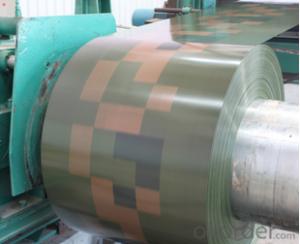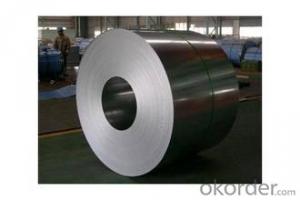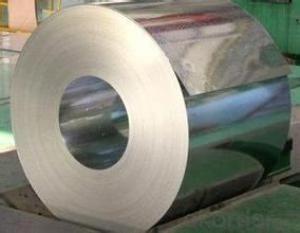Hot Dipped Galvanized/Aluzinc Steel Coil
- Loading Port:
- Shanghai
- Payment Terms:
- TT OR LC
- Min Order Qty:
- 25 m.t.
- Supply Capability:
- 9000 m.t./month
OKorder Service Pledge
OKorder Financial Service
You Might Also Like
Product Description
Commodity: Hot dipped galvanized steel coil
Size: Thickness: 0.20mm to 1.2mm; Width: 500mm to 820mm
Surface finish: Regular spangle; Small spangle
Surface treatment: Chromated passivation
Zinc coating: Z08, Z12, Z18
Packing: Mill's standard packing for exporting
Usage: used in the industries such as construction ,cold rolling forming and electro mechanics manufacturing, household electric appliance manufacturing and etc
Standard adopted: GB/T2518-1998;Also we supply such steel strips according to JIS,ASTM standard to meet users'requirements.
Steel grade: Q195,Q195L,SPCC(Other material require agreement )
Equivalent standard: JIS G3302 1998 or ASTM A653M/A924M 1998
Price Terms: FOB, CIF Term
Payment Terms: T/T, L/C at sight
Delivery: 15 days after receiving your valid L/C/down payment
| andard | EN 10142 EN 10147 | DX51D+Z, DX52D+Z, DX53D+Z SS250GD+Z, SS350GD+Z |
| JIS G3321 | SGCC, SGCD, SGCDD, SGC400 | |
| ASTM A792M | CS type C, CS type B, DS, SS250 | |
| Base Metal | Cold rolled steel coils SPCC, SPCD, SPCE, DC01, DC03, DC04, CS, DS, DDS, Q195, Q250, Q350 | |
| Thickness | 0.14mm-3.0mm | |
| Width | 600mm-1600mm | |
| Coil ID | 508mm, 610mm | |
| Zinc coating | 60g/m2-450g/m2 | |
| Surface treating | chromium free passivation, chromium passivation, fingerprint resistant, oiled | |
| Spangle types | Minimal spangle, zero spangle, regular and big spangle | |

- Q: What are the different coil leveling line configurations used for steel coils?
- There are several different coil leveling line configurations used for steel coils, including the single leveler line, the double leveler line, and the tandem leveler line. Each configuration offers unique advantages and is suited for specific coil leveling requirements. The single leveler line is the simplest configuration, featuring a single leveling machine that removes coil deformations. The double leveler line utilizes two leveling machines in tandem, allowing for improved flatness and surface quality. The tandem leveler line consists of multiple leveling machines in series, offering the highest level of flatness and precision. These different configurations cater to varying coil thicknesses, widths, and production demands, providing flexibility and efficiency in steel coil processing.
- Q: What are the dimensions of steel coils used in the electrical equipment industry?
- The dimensions of steel coils used in the electrical equipment industry can vary depending on the specific application and requirements of the equipment being manufactured. However, there are some common dimensions that are frequently used in this industry. Typically, the width of steel coils used in electrical equipment manufacturing ranges from 0.5 inches to 72 inches (1.27 cm to 182.88 cm). The thickness of these coils can vary from as thin as 0.005 inches (0.0127 cm) to as thick as 0.25 inches (0.635 cm). The length of steel coils used in the electrical equipment industry can also vary, but it is often determined by the manufacturing process and the specific equipment being produced. Coils can range from a few feet to several hundred feet in length. Furthermore, the weight of steel coils can vary depending on their dimensions and the type of steel being used. For instance, a common weight range for steel coils used in the electrical equipment industry is between 5,000 pounds (2,268 kg) and 50,000 pounds (22,680 kg). It is important to note that these dimensions are not fixed and can vary based on the specific needs of the electrical equipment industry. Manufacturers may have their own unique specifications and requirements for the steel coils they use in their products.
- Q: i am looking for an exact process of how to forge damascus steel.any tips or pointers and web sites or tutoreals will be helpfull.
- hand made folding knife English tip, blade of Damascus metallic sort Rose, 2,5mm thickness, no liners, teja spring embellished by using metallic report and billet surrounded of chrome metallic. A Damascus blade knife is characterised by using a wavy, mottled visual allure on the blade that’s led to by using the approach used to shape the metallic. the technique of transforming into Damascus metallic is derived from a centuries-previous forging technique used to create blades that grew to become very just about mythical of their attractiveness for power and sharpness it exchange into reported a Damascus knife ought to shrink with the aid of a rifle barrel to boot as with the aid of a hair falling on the blade.
- Q: Well im currently doing a project. Wanna help me? Because trust me, i really need it. You know how steel was created in China? If you didnt, you just learned something newww(: but anyways got any info on that? Websites? or just info from websites? Well lemme know because if its the best you get Best Answer Easy points right? (: Okay thanksss (:
- Steel is created in a primitive way whenever iron oxide ore (red dirt) is mixed with wood and burned. Seemingly everyone has a pet theory how their own selected country was the first to notice and do it on purpose. Regards, Larry.
- Q: I know that mild steel is more brittle than cast iron....but that is all.......please help??Thank you in advance......Ruby:D
- This Site Might Help You. RE: what is the diiferent in composition between mild steel and cast iron? I know that mild steel is more brittle than cast iron....but that is all.......please help? Thank you in advance......Ruby :D
- Q: How are steel coils used in the manufacturing of garage doors?
- Steel coils are used in the manufacturing of garage doors as they are formed and shaped into panels, which provide strength and durability to the doors. The coils are cut and rolled into specific dimensions, then coated with protective layers to enhance corrosion resistance. These panels are then assembled to create the sections of the garage door, ensuring a sturdy and long-lasting product.
- Q: How do steel coils contribute to the automotive aftermarket?
- Steel coils contribute to the automotive aftermarket by serving as a crucial raw material for manufacturing various components used in vehicles. These coils are responsible for providing strength, durability, and structural integrity to parts like body panels, chassis components, suspension systems, and exhaust systems. Additionally, steel coils are also used in the production of aftermarket accessories such as bumpers, grilles, and custom body kits. Their availability and versatility make steel coils an essential resource for the automotive industry, enabling the production of high-quality aftermarket products that enhance the performance and aesthetics of vehicles.
- Q: Having a new kitchen and would like to know the pros and cons of stainless steel as opposed to white appliances. I can only think of finger marks on the SS, which I believe are difficult to remove. Anyone had both that they could advise please?
- A relative had a stainless steel range. It always looked a fingerprinted mess. I have never liked it. To me, it is grey with a sheen. I hate grey. I am a white appliance person all the way. White makes the room look cleaner, brighter and larger and it is easy to keep clean. Stainless is a nightmare to keep clean. Almost forgot to mention, when we bought our house a few years ago, it had a stainless steel range, horribly marked and scratched. I got rid of it, in keeping with white.
- Q: How do steel coils contribute to the sustainability of construction projects?
- Steel coils contribute to the sustainability of construction projects in several ways. Firstly, steel is a highly durable and long-lasting material. Steel coils are manufactured to withstand extreme weather conditions, corrosion, and other external factors, making them ideal for construction projects that require strength and longevity. This durability reduces the need for frequent repairs and replacements, thus minimizing waste and resource consumption over time. Additionally, steel coils are recyclable. At the end of their lifespan in a construction project, steel coils can be easily and efficiently recycled. This process requires less energy compared to the production of new steel, resulting in reduced carbon emissions and environmental impact. Moreover, the recycled steel can be used in various industries, including construction, further promoting sustainability and resource conservation. Furthermore, steel coils contribute to the sustainability of construction projects by offering design flexibility. Steel is a versatile material that can be easily shaped, cut, and molded into different forms and sizes. This allows for efficient construction practices, reducing material wastage and optimizing resource utilization. Additionally, the lightweight nature of steel coils allows for ease of transportation and installation, further reducing fuel consumption and associated greenhouse gas emissions. Lastly, steel coils contribute to the sustainability of construction projects through their energy efficiency. Steel is an excellent conductor of heat and electricity, making it ideal for energy-efficient buildings. Steel coils can be used in the construction of walls, roofs, and other components that help to insulate buildings and reduce energy consumption for heating and cooling. This results in lower energy bills for the occupants and reduces the overall carbon footprint of the construction project. In conclusion, steel coils contribute to the sustainability of construction projects through their durability, recyclability, design flexibility, and energy efficiency. By using steel coils, construction projects can reduce waste, conserve resources, minimize environmental impact, and optimize energy consumption, thus promoting a more sustainable and environmentally friendly approach to construction.
- Q: How are steel coils used in the production of electrical transformers?
- Steel coils are used in the production of electrical transformers as they provide the core structure for the transformer. The steel coils are wound with insulated copper wire to create the primary and secondary windings of the transformer, which allow for the transformation of electrical energy from one voltage level to another. The steel coil helps to conduct and distribute magnetic flux within the transformer, ensuring efficient energy transfer and reducing losses.
Send your message to us
Hot Dipped Galvanized/Aluzinc Steel Coil
- Loading Port:
- Shanghai
- Payment Terms:
- TT OR LC
- Min Order Qty:
- 25 m.t.
- Supply Capability:
- 9000 m.t./month
OKorder Service Pledge
OKorder Financial Service
Similar products
Hot products
Hot Searches
Related keywords




























